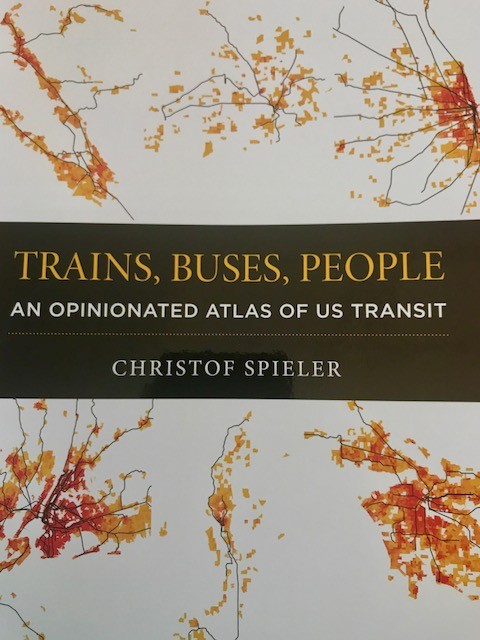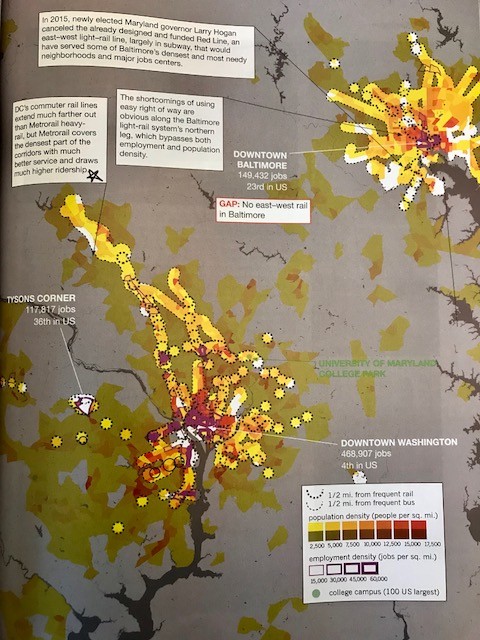The Washington region has good transit compared to others, a new “opinionated atlas” says

Trains, Buses, People: An Opinionated Atlas of US Transit by Christof Spieler Image by the author.
Let’s start with the obvious: Trains, Buses People: An Opinionated Atlas of US Transit belongs on an urbanist’s bookshelf.
Christof Spieler, an urban planner and former Houston Metro board member, has written one of the best transit/planning books I’ve read in a long time. Released in October 2018, his assessments of what makes for good transit and well-researched profiles of 47 metro areas give you the foundation necessary for having an insightful conversation about transit in DC, Baltimore, or wherever you might be.
I thoroughly enjoyed Spieler’s analysis of transit in the Washington region and his comparisons of various metro areas around the country. The accessiblity and candor of the analysis is similar to other books GGWash contributors have recommended and reminded me of The Works, Kate Ascher’s book about public works infrastructure and how things like roads, transit, and sewers make places livable. Both describe wonky topics through approachable language and easy-to-digest visuals.
Most planning books tend to be on the academic side; Trains, Buses, People is not. Its approachable prose works for various audiences – elected officials, urbanist policy wonks, and those family members who don’t understand your urban policy interests but would like to.
47 Metro-area profiles are the majority of the book
Don’t let the 243 page, inch-thick book scare you. The first two sections feature topics often discussed here at GGWash, such as the various types of transit (local bus, heavy rail, light rail, etc.) and the importance of frequency of service. The last section, though, is the meat of the book – profiles detailing the transit service available in 47 metro areas across the United States.
Each profile identifies the agencies that operate rail or bus rapid transit in the metro area, and provides more details about the transit service itself – whether it's a big or small system, new or old, high-performing or low-performing, etc. This analysis of its performance is where the word “opinionated” in the book’s subtitle becomes important. That doesn't mean his opinion isn't well-founded though. For many of the profiles, particularly DC, I found it hard to argue with Spieler’s conclusions.
Washington DC Metro Area profile. 
What it says about DC and Baltimore
The full profile for our region is eight pages with a mix of text and maps. He reviews VRE, MARC, the DC Streetcar, even the forthcoming Purple Line.
Spieler names Washington, DC as one of the country’s best transit cities in the ranks of New York City, Boston, San Francisco, and Seattle. He also acknowledges the “significant maintenance and capacity issues” we have, but mostly focuses on the strength of transit in our region compared to other cities across the country.
He notes, “the city, and its suburbs, have transformed around transit more than any other city.” That’s true as well. The deliberate decision to build rail instead of interstates made the region what it is today. The District and its inner suburbs like Arlington bucked the post-World War II auto-oriented development trend.
The metro area profile combines DC and Baltimore, which reinforces the contrast between the two transit systems. Baltimore has one of the country’s lowest performing heavy rail lines, and the city’s light rail line does not perform much better. Simply put, the type of transit investment that occurred in DC did not happen in Baltimore, which has negatively impacted the citizens of Baltimore and more broadly, the entire metro area.
I wish there was more discussion about equity
Spieler’s conciseness is a benefit, so I understand why he doesn’t deviate from his thesis much. But there is one thing I wish he had discussed in more depth: equity. Spieler briefly discusses the canceled Red Line in Baltimore and how it would have served those who need frequent, reliable transit the most. He points out the gap in east-west rail service in Baltimore and notes it on one of his maps.
But Spieler glosses over transit equity in his DC analysis. Spieler presents a Transit Agenda in his conclusion, but it too does not mention equity (although it does mention policy changes, such as zoning and minimum parking requirements that impact equity). It would be nice to see analysis on who is being served by transit, particularly by frequent transit. This would add to the value of Spieler’s analysis on what and where good transit is being served.
Whether you are a loyal GGWash reader or a first-timer interested in learning more about urbanist issues, Trains, Buses, People has insights you’ll enjoy.
